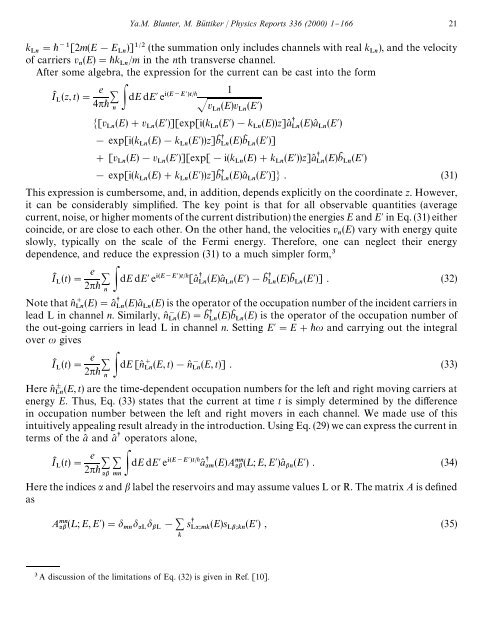shot noise in mesoscopic conductors - Low Temperature Laboratory
shot noise in mesoscopic conductors - Low Temperature Laboratory
shot noise in mesoscopic conductors - Low Temperature Laboratory
You also want an ePaper? Increase the reach of your titles
YUMPU automatically turns print PDFs into web optimized ePapers that Google loves.
Ya.M. Blanter, M. Bu( ttiker / Physics Reports 336 (2000) 1}166 21<br />
k "[2m(E!E )] (the summation only <strong>in</strong>cludes channels with real k ), and the velocity<br />
<br />
of carriers v (E)"k /m <strong>in</strong> the nth transverse channel.<br />
<br />
After some algebra, the expression for the current can be cast <strong>in</strong>to the form<br />
IK (z, t)"<br />
e<br />
4 <br />
1<br />
dE dE e <br />
v (E)v (E)<br />
<br />
[v (E)#v (E)][exp[i(k (E)!k (E))z]a( (E)a( (E)<br />
<br />
! exp[i(k (E)!k (E))z]bK (E)bK (E)]<br />
<br />
# [v (E)!v (E)][exp[!i(k (E)#k (E))z]a( (E)bK (E)<br />
<br />
! exp[i(k (E)#k (E))z]bK (E)a( (E)] . (31)<br />
<br />
This expression is cumbersome, and, <strong>in</strong> addition, depends explicitly on the coord<strong>in</strong>ate z. However,<br />
it can be considerably simpli"ed. The key po<strong>in</strong>t is that for all observable quantities (average<br />
current, <strong>noise</strong>, or higher moments of the current distribution) the energies E and E <strong>in</strong> Eq. (31) either<br />
co<strong>in</strong>cide, or are close to each other. On the other hand, the velocities v (E) vary with energy quite<br />
<br />
slowly, typically on the scale of the Fermi energy. Therefore, one can neglect their energy<br />
dependence, and reduce the expression (31) to a much simpler form,<br />
IK (t)"<br />
e<br />
2 <br />
dE dE e [a( (E)a( (E)!bK (E)bK (E)] . (32)<br />
<br />
Note that n( (E)"a( (E)a( (E) is the operator of the occupation number of the <strong>in</strong>cident carriers <strong>in</strong><br />
<br />
lead L <strong>in</strong> channel n. Similarly, n( (E)"bK (E)bK (E) is the operator of the occupation number of<br />
<br />
the out-go<strong>in</strong>g carriers <strong>in</strong> lead L <strong>in</strong> channel n. Sett<strong>in</strong>g E"E# and carry<strong>in</strong>g out the <strong>in</strong>tegral<br />
over gives<br />
IK (t)"<br />
e<br />
2 <br />
dE [n( (E, t)!n( (E, t)] . (33)<br />
<br />
Here n( (E, t) are the time-dependent occupation numbers for the left and right mov<strong>in</strong>g carriers at<br />
<br />
energy E. Thus, Eq. (33) states that the current at time t is simply determ<strong>in</strong>ed by the di!erence<br />
<strong>in</strong> occupation number between the left and right movers <strong>in</strong> each channel. We made use of this<br />
<strong>in</strong>tuitively appeal<strong>in</strong>g result already <strong>in</strong> the <strong>in</strong>troduction. Us<strong>in</strong>g Eq. (29) we can express the current <strong>in</strong><br />
terms of the a( and a( operators alone,<br />
IK (t)"<br />
e<br />
2 <br />
dE dE ea( (E)A<br />
(¸; E, E)a( (E) . (34)<br />
<br />
Here the <strong>in</strong>dices and label the reservoirs and may assume values L or R. The matrix A is de"ned<br />
as<br />
A<br />
(¸; E, E)" ! s (E)s (E) , (35)<br />
_ _<br />
<br />
A discussion of the limitations of Eq. (32) is given <strong>in</strong> Ref. [10].
















